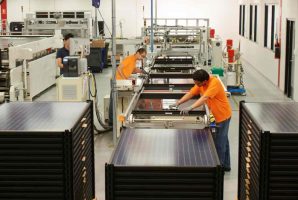Plans to develop critical Australian offshore wind industry infrastructure in Victoria’s Port of Hastings have hit a wall, after being ruled out by the federal government for posing a “clearly unacceptable” environmental risk.
Preliminary plans for the Victorian Renewable Energy Terminal were submitted to the federal Department of Climate Change, Energy, the Environment and Water by the Port of Hastings Corporation in October.
Following a notification published late last week, and signed off by federal environment minister Tanya Plibersek on December 18, the project’s status has been updated to “clearly unacceptable” due to impacts on the Western Port Ramsar wetlands, which are internationally protected.
“The project was deemed clearly unacceptable under national environment law and cannot proceed,” a spokesperson for the Department of Climate Change, Energy, the Environment and Water told AAP on Monday.
The decision strikes a major blow in the race to deliver Australia’s first round of offshore wind farms. The Port of Hastings is the closest deep-water port to the nation’s first official development zone off the coast of Gippsland in Victoria’s south-east.
It has also been identified as the preferred primary construction port for the 2.2GW Star of the South project – likely to be Australia’s first offshore wind farm.
The Western Port Bay location had also been identified by the Victorian government as most suitable for a central hub to support the state’s offshore wind targets of at least 2GW of capacity by 2032, 4GW by 2035 and 9GW by 2040.
As RenewEconomy reported in October, the EPBC referral documents proposed the Terminal be built over an area of 146 hectares at the site at the Old Tyabb Reclamation Area, an area that includes the Ramsar wetlands.
The proposed project would require clearing of vegetation and dredging of the seabed to allow deeper ship access, as well as construction of a wharf structure of around 600m long by 100m wide that would be capped with a concrete apron.
The Port of Hastings on Monday declined to comment on the federal government’s decision, but a spokesperson told RenewEconomy that it was considering its options and would provide an update on its plans in due course.
A Victorian government spokesperson said the state was assessing the Commonwealth’s feedback to determine the next steps, but stressed it still considered the port development as “key” to the success of Australia’s nascent offshore wind industry.
“Victoria is proud to be developing Australia’s first offshore wind industry, which will be crucial for delivering national energy security and create thousands of jobs right here in Victoria. The Victorian Renewable Energy Terminal is key to achieving this,” an emailed statement said.
The Star of the South, which undertook a year-long analysis of port options across 2022-23, says Geelong Port and the Port of Bell Bay were also identified as as options to support the pioneering project’s construction. But the company has also noted that more than one port is expected to be needed for the construction phase.
“The assessment is a matter for government,” said Star of the South CEO Charles Rattray in a statement on Monday.
“We’ll continue to work with a range of ports and all levels of government as we plan for Star of the South and seek to advance Australia’s offshore wind industry,” Rattray said.
Ultimately, the federal government’s call on the Port of Hastings does not come as a complete surprise, considering protection of the Ramsar Wetlands was central to the 2022 Victorian government decision to reject a proposal for a 300-metre-long floating gas terminal in Western Port.
“It’s very clear to me that this project would cause unacceptable impacts on the Western Port environment and the Ramsar wetlands — it’s important that these areas are protected,” Victoria’s planning minister Richard Wynne said of his decision on the gas terminal.
That said, the rejection of what is broadly considered a vital piece of national renewable energy infrastructure sits in uncomfortable contrast with the recent spate of coal project approvals from the federal government.
As the Climate Council noted in October, a court case fought by the Environment Council of Central Queensland last year shone a spotlight on a “gaping hole” at the heart of Australia’s environmental law, with government not required to consider climate threats when assessing new fossil fuel projects.










